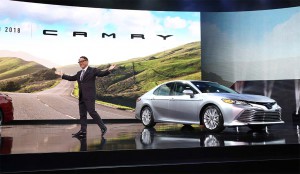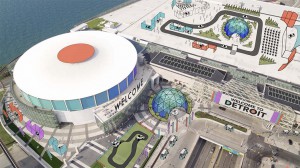The North American International Auto Show will move from January to June in 2020, a new timeslot that organizers are betting will help revive the flagging momentum of what had long been one of the industry’s most important annual events.
The Detroit Auto Dealers Association had signaled its intention of abandoning its traditional, mid-winter schedule, though a switch to October was also under study. But that would have conflicted with other shows in Europe and Asia, the dealer group’s Executive Director Rod Alberts told TheDetroitBureau.com in an exclusive interview.
In a background briefing ahead of today’s official announcement, Alberts said one of the advantages of a summer event is the ability to add new functions that expand beyond the confines of Detroit’s sprawling Cobo Hall convention center. “We realized we have to change the show (and) showcase Detroit, too,” said Alberts, who has been running the DADA for the past 28 years.
Auto shows, in general, have begun to struggle as automakers weigh the hefty costs associated with setting up stands and, at major events like the NAIAS, staging news conferences. Costs can run into the millions of dollars and, in some cases over $10 million, when flashy product debuts are factored in.
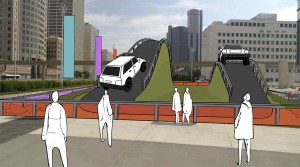
The June move will allow adding new outdoor functions, like a consumer ride-and-drive. (Renderings provided by the DADA.)
Along with the warmer weather and expanded range of event possibilities, DADA organizers promise that they will be able to significantly speed up the time it takes to move into Cobo before the show begins, something that is expected to slash event costs.
The Motor City has staged car shows for the better part of a century, but what was typically a domestic brand-focused event shifted into a global powerhouse in 1989, getting a boost with the dual launches of Toyota’s Lexus brand and Nissan’s own new luxury marque, Infiniti.
(Audi out at NAIAS. Click Here for more on why Detroit was pushed to make major changes.)
At its peak, as many as 70 different vehicles were unveiled during media previews that, at one time, filled three full days. This past year saw less than half that total, with barely a full day of news conferences. And the next few years promised to get worse. With such brands as Mazda, Volvo, Jaguar and Land Rover absent for the 2018 show, Mercedes-Benz, BMW and Audi planned to skip out in January 2019.
Detroit, however, hasn’t been the only car show to struggle. The Tokyo Motor Show, once a biennial must-attend event, fills only a fraction of the space it required a decade ago and relatively few foreign brands still participate. The Paris Motor Show, which alternates every other year with the Frankfurt Motor Show, has also been hit with major defections. Last month, Fiat Alfa Romeo and Jeep said they would drop out, joining planned no-shows BMW, Ford, Infiniti, Mazda, Mitsubishi, Nissan, Opel, Subaru, Volkswagen and Volvo. Frankfurt is expecting to see an exodus, next year.
(Ford joins auto show exodus as it pulls out of 2019 Geneva event. Click Here for more.)
Earlier this year, Mike Jackson, the CEO of auto retail giant AutoNation, said auto shows are becoming “dinosaurs.”
Cost is a major part of the problem, but automakers have also started shifting to alternative venues, ranging from classic car shows like the annual Pebble Beach Concours d’Elegance in August, to January’s Consumer Electronics Show in Las Vegas, which has become a popular place for automakers to talk about their increasingly high-tech vehicles.
Detroit organizers have had some success adding a high-tech component, Automobili-D, to the North American International Show and are hoping it will grow even more with greater distance from CES.
They plan to take advantage of space nearby the sprawling Cobo convention center to add more crowd-pleasing functions that could range from automaker-hosted concerts in the adjoining Hart Plaza riverfront park to a field of food trucks.
Alberts said industry officials showed particular interest in setting up vehicle ride-and-drives, something that would allow manufacturers to, in industry parlance, “put butts in seats,” and go beyond the traditional auto show static display.
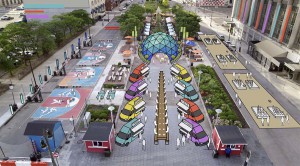
The plan calls for luring local residents and workers during the week with features like a food truck park.
“Reinventing NAIAS as a summertime festival of design, speed and innovation is incredibly exciting,” said Mark Truby, the head of communications at Ford Motor Co., whose department strongly influences where the Detroit automaker will invest in product debuts and consumer showcases.
The summertime schedule will add the ability to showcase the increasingly vibrant City of Detroit which is making a rapid revival after decades of decline. That was impossible to do during the dead of winter, Alberts acknowledged.
“With a new summer timeframe, industry leaders and international media will see Detroit in a new light, paving the way for exciting outdoor activities and more opportunities to explore this vibrant city,” said Scott Vazin, Truby’s counterpart at Toyota Motor North America.
Whether the June NAIAS will be able to lure back manufacturers like Mazda, Volvo, Audi or Jaguar is yet to be seen, though Alberts hinted that some absentees have expressed interest in a return, hinting “You’ll have some of them back.” When it announced the pull-out of Mercedes in January, Daimler AG CEO Dieter Zetsche pointedly left the door open for coming back in 2020.
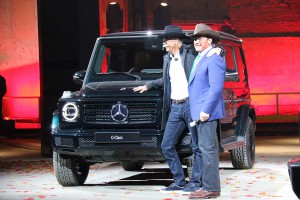
Daimler CEO Dieter Zetsche - shown at the 2018 NAIAS with Arnold Schwarzenegger - has said Mercedes would consider a 2020 return.
Meanwhile, organizers are hoping to attract new players in the market, notably the numerous Chinese brands who hope to soon crack into the U.S. market. Guangzhou-based GAC Motors came to Detroit in 2018 and its president Yu Jun said, “Detroit will continue to serve as a critical part of our global marketing strategy and we look forward to the new exciting opportunities June will offer.”
For budget-conscious marketing departments, what could prove to be a critical change is the DADA’s promise to slash set-up time at Cobo Hall. Traditionally, the “move-in time” ran between eight to 12 weeks and, because that squatted on top of both the Thanksgiving, Christmas and New Year’s holidays, it added significant overtime costs to coming to Detroit.
The target is to reduce that to three weeks for 2020 and as little as two in future years, Alberts estimating the cost savings “easily” will run into the millions of dollars for the typical automaker.
Not everyone is convinced Detroit can recover its former glory. The new timeslot extends the auto show season which traditionally ended in April with events in New York and, alternatively each year, Beijing and Shanghai. But Alberts is confident it will prove a good time to debut products for the following model-year, especially as the once-sacred October launch of new models stretches into subsequent months.
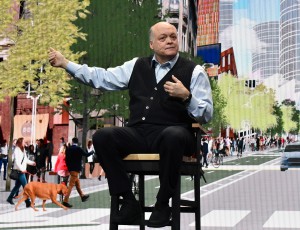
NAIAS will still face competition from non-tradition events like CES - Ford CEO Jim Hackett shown during a presentation last January.
(Toyota joins list of carmakers turning to CES. Click Here for the story.)
Detroit will nonetheless have to battle it out with competing events, both traditional car shows and new events like CES. But organizers point to a new study by Prime Research to make their point. It shows 809,000 people attended the 2018 NAIAS – including more than 5,000 journalists from around the world — creating an economic impact of $480 million “the equivalent of two NFL Super Bowls.” That includes everything from salaries to new car sales. The study indicates that from a new perspective, NAIAS generated more “reach” and published articles than even the show in media-centric New York.
Whether the new strategy works won’t be clear for some time. The NAIAS will remain in its old, January timeslot for 2019 and then switch to June in 2020. The precise dates haven’t been announced though it’s expected to start sometime during the week of the eighth, but the show will also tie up with other events, likely also including the annual Detroit Grand Prix held on the city’s island park, Belle Isle.

